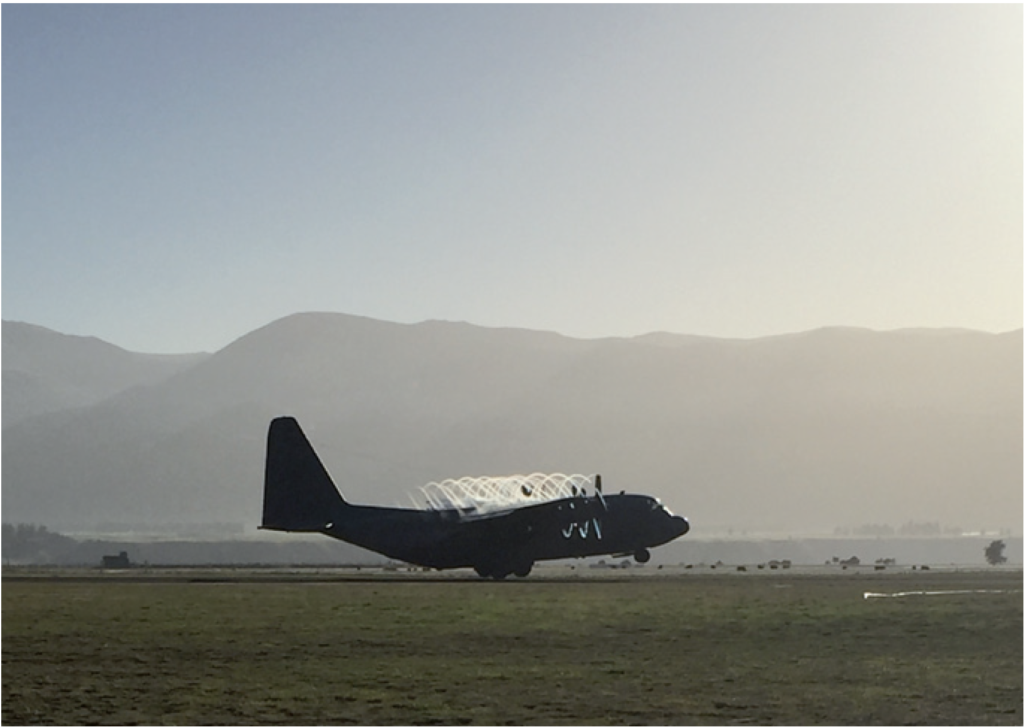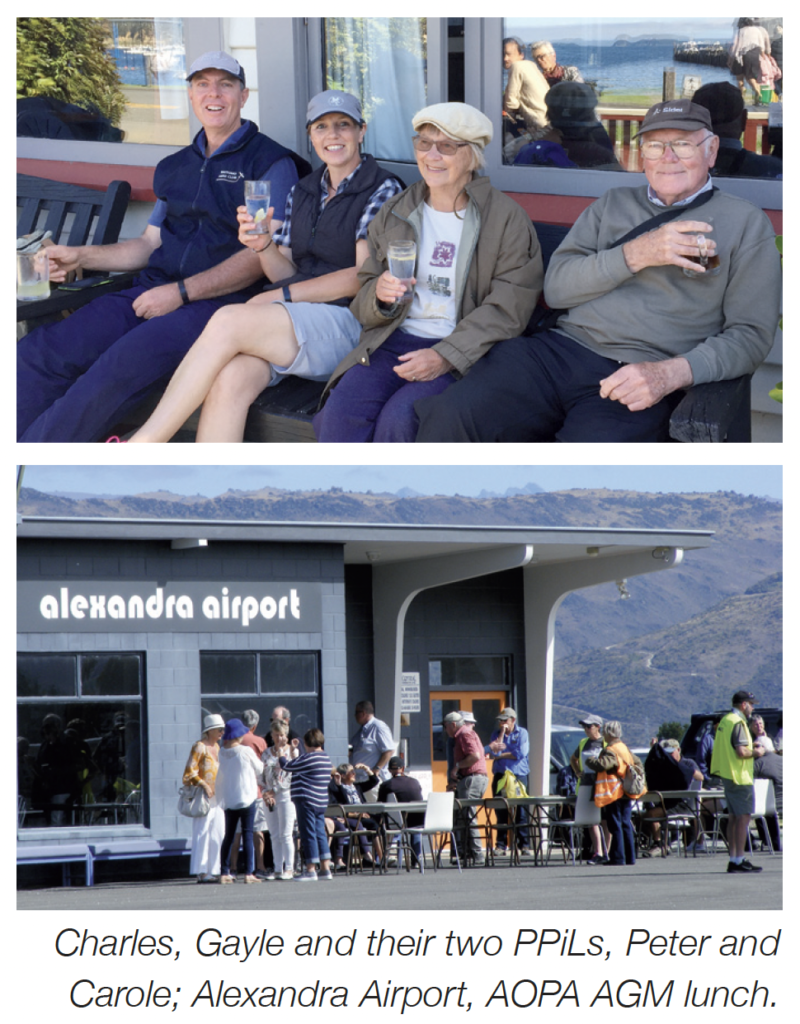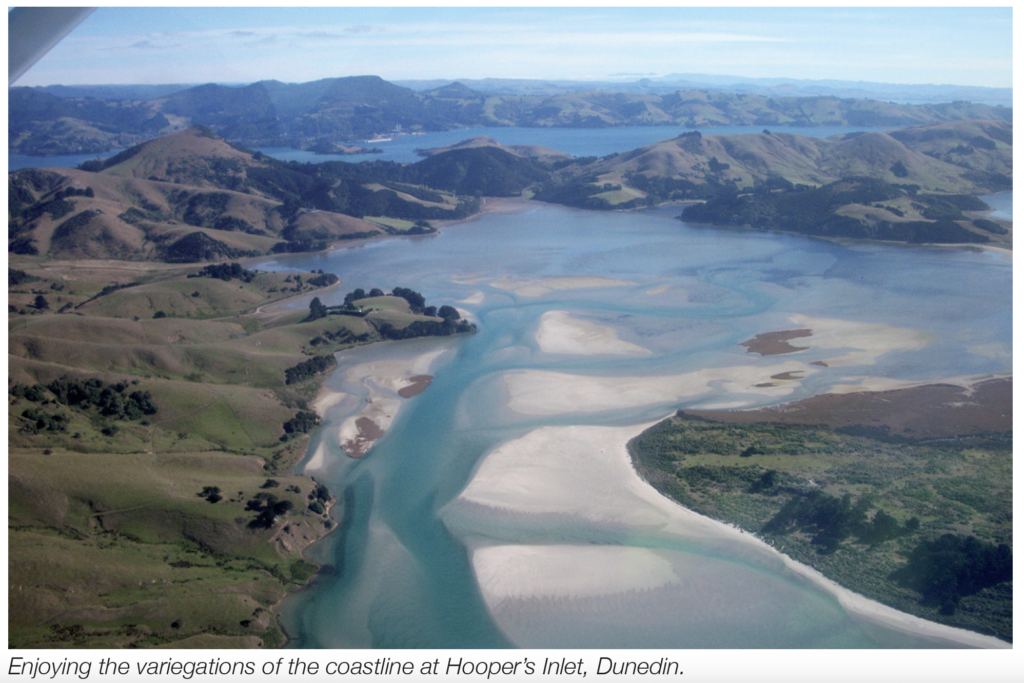By Gayle Wilson
With Cromwell the venue for the 50th Anniversary of AOPA NZ, Charles and I decided we would follow it with a safari of southern New Zealand. As a delayed 80th and so they could experience what we love doing, we invited my parents, Peter and Carole, to join us.
Dad and Mum are adventurous (eg: driving the whole continent of Africa), thus were issued the title PPiL (private passenger in-law). As our Cessna 182 ZK-DNZ would be fully loaded, Charles allocated a maximum of 7kg (shock, horror!) baggage per person. This caused many sleepless nights: I normally pack more for a weekend away, let alone ten days. Needless to say, we managed it.
We departed Te Kuiti for Cromwell Racecourse on 18 March, a day early, as we wanted to meet up with Sue Kronfeld of Classic Flights in Wanaka for a mountain flying course which would allow Charles to ‘earn some currency’. Our trip took us via Omaka and Rangiora for fuel. There was a fair bit of cloud over Cook Strait and the Sounds were not great, so a scenic tour was abandoned in favour of hot chocolate at the Omaka café, much needed due to the cold. Our plan from there had been to track along the Clarence or Awatere but, after speaking to some locals, we decided to track along the coast.
Typically of New Zealand weather, Rangiora was warm and sunny. We were first to arrive at Cromwell Racecourse and, shortly after shutting down, discovered DNZ’s battery had given up the ghost. Steve Lyttle came to our rescue with an overnight battery charge and an early morning lift to the airfield. A huge thank you, Steve.

The following day, with the battery successfully charged, we flew to Precision Aviation at Wanaka to make sure it was just the battery and nothing more serious, like the alternator. The Air Force was operating out of Wanaka and I took a photo of their Hercules C180 at take off with the dew point and sunrise just perfect to capture the prop wash vortices.
With a new battery installed we taxied to Classic Flights for a three hour mountain flying course with Sue Kronfeld. Our main objective was to understand flying at altitude and dealing with the resulting lack of power. Not only did we learn about finding the energy (updrafts) but also about the illusion effect caused by the mountains (being further away than you think) and that the best plan B is to have a plan C as well. The course was well worth the time and money; we recommend it to all pilots who are novices to the Alps and mountain flying.
At the end of the flight, we noticed DNZ had developed a slight oil leak. Twenty24 at Wanaka very kindly ‘squeezed’ us into their work schedule and repaired the leak. We were so grateful as it meant we could continue our journey with peace of mind. Lucky for us it was a very simple fix. Thanks also to Kevin for the use of a car.
Anniversary celebrations The AOPA programme included a different type of flying: around the GoKart track or, for some lucky folk, fast laps of the Highland Motor Park track in a McLaren, reaching speeds up to 208km/h. The Go-Karts proved rather competitive and Charles learnt an important lesson – let your wife pass!
That afternoon saw the 50th anniversary celebrations begin with reminiscences from ‘The Kittyhawk Originals’ followed by carriers of the flame and lastly younger aviators who had grown up within the AOPA organisation. It was most interesting and Ian Sinclair was a fantastic MC.

The AGM was the following morning. During discussion someone suggested AOPA NZ is more of a South Island organisation. That may be argued due to its origins, however AOPA’s advocacy work benefits all New Zealand GA pilots. As North Islanders, we’re proud to be affiliated with the organisation – and it has introduced us to a great bunch of people too.
The afternoon consisted of a flight to Alexandra for lunch, provided by The Lions, followed by three strip landings. Alexandra Airfield has a few two-person accommodation cabins with hangars for those who wish to make Alexandra either a base or layover. Southern adventure Monday morning and time for everyone to part ways.
After goodbyes to friends, commonly including the phrase ‘See you in Haast for the Winter fly-in’, it was time to continue our adventure. Mum and Dad would like to thank all of the members for their warm hospitality.
Departing Cromwell Racecourse we tracked along the Clutha River for Dunedin then followed the coast south. On approach to Invercargill, incoming sea fog forced us inland, diverting us to Gore for fuel. The Stewart Island flight pilots confirmed that Stewart Island was clear as far as the eye could see, with only Invercargill fogged in and a no-go.
It is important to note that you require permission to land at Ryans Creek. The first step is to complete their form, which gets filed. Permission is only granted once you have spoken to Stewart Island flights for a verbal weather and strip briefing. Your arrival and departure time is dictated by the commercial flight operations.
We were booked for two nights at Stewart Island, staying at The Argyle Apartments. These are new, modern and within 400m of the pub, shop and activities. A gorgeous view of Halfmoon Bay from the deck, complete with sundowners, ended the day perfectly.

The following day was designated a rest day, though perhaps Charles and I need a dictionary for Christmas: we walked the whole of Ulva Island and cycled all 27km of Oban’s roads. perhaps not so restful but great. We will most definitely return and stay longer. On 24 March, with more clear skies, we flew the whole coast of Stewart Island. It’s size was a revelation, as was the amount of untouched land. The plan was to then fly to Te Anau for fuel, followed by a visit in and around Milford Sound, before finishing up at Haast.
We had spoken to quite a few AOPA members about Milford during the course of the celebrations at Cromwell and ascertained that one needs to get an airfield briefing, which we got. The AIP states that permission from DoC is needed to land. What it does not say is that DoC requires a minimum of five working days to process. Based on this, we decided that we would have to miss landing at Milford Sound this time round. I have subsequently found out that, as a member of AOPA, one can land under a joint concession which negates the need for prior approval. This information might beneficially be made more available to members, and I wonder whether other landing strips are also covered under a concession. I suppose that’s the penalty one pays for not being a local. (See the following article for further information on flying into Milford under the concession.)
Fiordland turned out to be completely blanketed by low cloud and the AOPA webcams did not paint a pretty picture. We instead headed inland to Mandeville for lunch, as we heard it had a good café and great coffee. Our plan B was to head back to Wanaka and make further decisions there. Low and behold, clear sky, so we tracked over Lake Hawea and up into the Alps. Mum and Dad had previously been in the Southern and European Alps by campervan; this was their first experience by air. When I looked over at Mum she had a smile from ear to ear and an expression of combined awe and tranquillity. Dad was totally speechless (well, almost). “What is there left for us to do?” he asked. It demonstrated how truly lucky we are as aviators (and family of), enjoying experiences inaccessible to most. The Landsborough valley was clear, which allowed us to track into Haast to our pre-booked accommodation.
Next morning we woke to cloud around 3500ft. With Rangiora our goal, we took off and orbitted over Haast to gain height. The clouds were thin enough to reveal all the splendour of the Alps. The view was more mystical than the previous day, clouds ‘flowing’ over some saddles giving the appearance of waterfalls.
The weather was completely different when we reached the Canterbury plains: low cloud around 800ft, so we picked our way through some holes in order to get above it on track for a very sunny Rangiora. We spent the night catching up with some long-time friends, the perfect final night of our trip.

Setting off in great weather the following morning, we tracked the Clarence River en route Omaka. This valley is still one of my favourites and, thanks to my screensaver, I relive the memory daily. Taylor Pass into Omaka offered the first turbulence of the trip, continuing out over the Sounds due to a gusty northerly. It provided a classic rollercoaster ride; certainly not pleasant, so up and up we went to a ceiling of 9500ft, where it was lovely and smooth, homeward bound.
This article first appeared in the Winter 2021 edition of Approach Magazine, the dedicated magazine of AOPA NZ, which is published quarterly.

